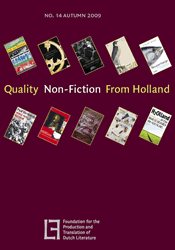QNF 2009
This year’s selection opens with a book that is impressive in every sense, telling a great story that places the birth and development of the European Union in the context of the political history of Europe. Luuk van Middelaar was one of the Netherlands’ most promising philosophers when he made his debut ten years ago with Politicide (see QNF 2000). Since then he has gained direct political experience in Brussels and The Hague and used it to write this standard work.
Jona Lendering is a familiar name in QNF brochures, which have featured his City in Marble (see QNF 2003) and Alexander the Great (QNF 2004). His new book takes a stance in the debate about the clash of civilizations by pointing to the huge influence of the Islamic world on Western civilization: we are closer to mediaeval Baghdad than to classical Athens.
Peyman Jafari brings East and West together in his own life and work. Born in Iran, he has lived in the Netherlands for the past twenty years. No one is better able to explain modern Iran to a Western reader, and to reveal a different side to the image served up by the media.
Kester Freriks and Steven Adolf are very different writers, the first having a literary background while the second is a journalist, but both have written books about animals. The Falcon is the story of a personal passion, interwoven with the history of falconry. Giant Tuna describes the dramatic decline of this fish, which may disappear altogether within a few years, even though the alarm was first raised only a couple of years ago.
Film director Paul Verhoeven is a clear outsider in this brochure, but his debut as an author was an instant success. Jesus of Nazareth was favourably received, more than 20,000 copies were sold, and translation rights have been bought in five countries. Perhaps there will now be a film.
Biographies of famous Dutch people are sadly far from abundant, which is why a biography from several years ago has been included this time. Scientist Christiaan Huygens became famous for inventing the pendulum clock, but beyond that he was a dominant figure on the seventeenth-century European scientific stage.
Fifteen years ago Rik Smits published a thoroughly original book about left-handedness, and since then he has written a handbook about the Dutch language. Now he delves deeper into history, to the origins of language itself, and once more his findings are highly original, dispatching many myths.
Nicolaas Matsier has been a respected novelist and translator for many years. In The Eye Deceived he pursues his passion for the trompe l’oeil, producing the first general survey of the phenomenon to be written in Dutch. From an international perspective most reference books on the subject are outdated, but the world’s museums clearly remain interested (this autumn a trompe l’oeil exhibition will be held in Florence).
No book was available about the Dutch and water, and fortunately it was Maarten Asscher who stepped into the breach. He is ideally suited to treat a subject like this in an elegant, incisive and erudite manner. From many unexpected angles and with irrepressible good humour he observes the Netherlands as a saturated waterland.
The brochure ends with an overview of the most notable translations of the past year. In 2008 and 2009, Dutch non-fiction titles were still mostly translated into English and German, but Chinese has now joined them - an important emerging market for Dutch literature.
Maarten Valken
Published: October 6, 2009 features | non-fiction

Quality Non-Fiction 2009
